Learn Biochemistry on the Coast of Maine
Let UNE’s Biochemistry degree be the gateway to your career in the thriving bioscience industry, or build on it as the cornerstone of your health professions training or other graduate study. Either way, you reap the benefits of being part of a comprehensive health sciences university that offers training in state-of-the-art lab techniques and sophisticated instrumentation. You’ll discover an uncommon breadth of undergraduate research opportunities that will develop your skills and put you ahead of the curve.
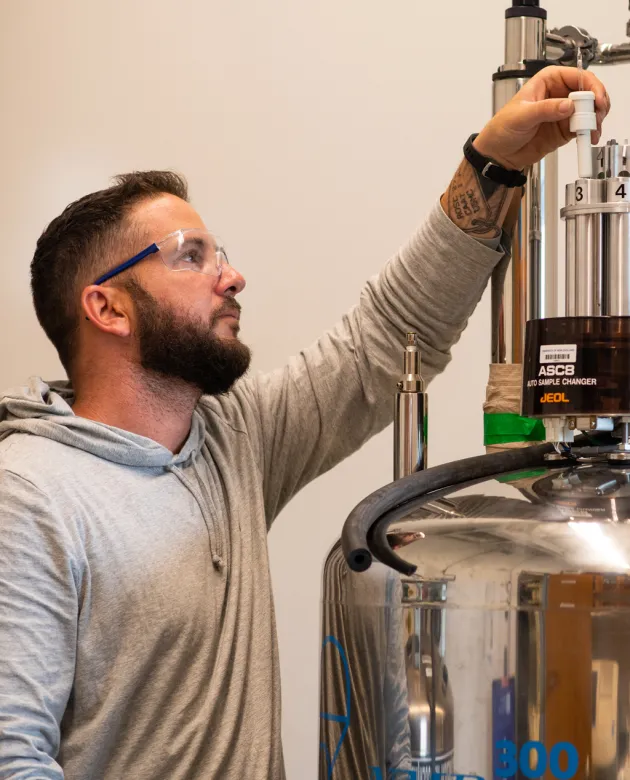
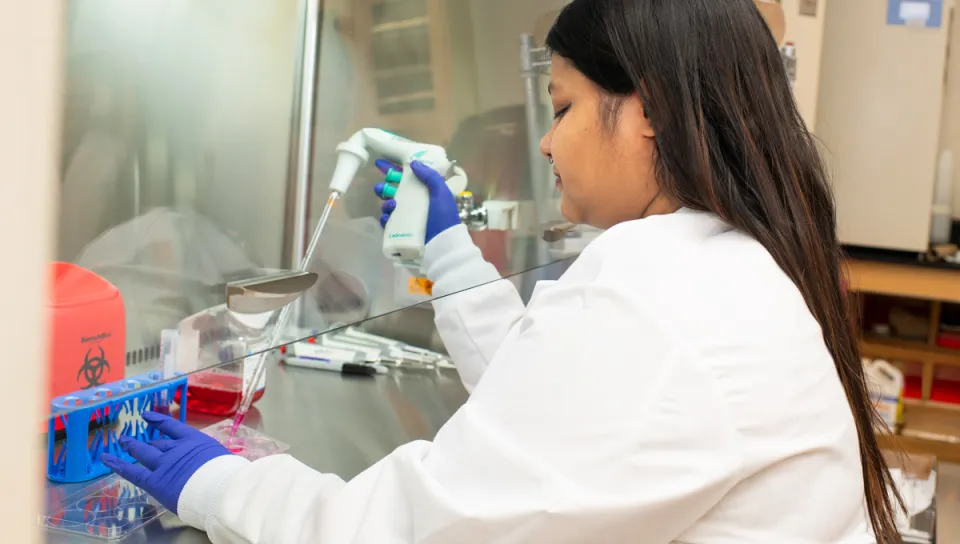
Why UNE for Your B.S. in Biochemistry
Biochemistry at UNE offers all the advantages of a major research university. Yet, nestled within the College of Arts and Sciences, the program provides you with close faculty relationships and one-on-one attention. The result? Exposure to a range of research opportunities that is rarely found at the undergraduate level.
- Training in state-of-the-art lab techniques
- Focus on independent experimental design
- Proximity to health professions programs
- Formal and informal peer mentoring
- Teaching assistantships
- Abundant local internship opportunities
What will you study? Biochemistry Degree Curriculum Overview
B.S. in Biochemistry Courses
There are many ways you can navigate our Bachelor of Science in Biochemistry. The following are just some examples of the exciting courses that you can take:
- Advanced Biochemistry Lab
- Computational Chemistry
- Medicinal Chemistry
- Quantitative Analysis
- Advanced Lab
- Physical Chemistry
Curriculum
| Nor’easter Core Requirements | Credits |
|---|---|
| Total Credits | 40 |
| Program Required Courses | Credits |
|---|---|
| BIO 105/105L – Bio I: Ecology/Evolution w/Lab | 4 – Fulfills Scientific Method Core |
| BIO 106/106L – Bio II: Cellular/Molecular w/Lab | 4 |
| BIO 214/214L – Genetics w/Lab | 4 |
| BIO 370 – Cell and Molecular Biology | 3 |
| CHE 150/150L – University General Chemistry I w/Lab** | 4 |
| CHE 151/151L – University General Chemistry II w/Lab** | 4 |
| CHE 250/250L/250S – University Organic Chemistry I w/Lab and LabLecture* | 5 |
| CHE 251/251L/251S – University Organic Chemistry II w/Lab and LabLecture* | 5 |
| CHE 307/307L – Quantitative Analysis w/Lab | 5 |
| CHE 327 – Applied Physical Chemistry or CHE 371 – Physical Chemistry II | 3 |
| CHE 350/350L – Biochemistry I: Proteins w/Lab | 5 |
| CHE 351 – Biochemistry II: Metabolism and Bioenergetics | 3 |
| CHE 375 – Advanced Laboratory or CHE 417/417L – Instrumental Methods of Analysis w/Lab or CHE 450 – Advanced Biochemistry Laboratory | 2–4 |
| CHE 401 – Chemistry Seminar | 1 |
| MAT 190 – Calculus I | 4 – Fulfills Quantitative Reasoning Core |
| MAT 195 – Calculus II | 4 |
| PHY 210 – University Physics I* | 4 |
| PHY 211 – University Physics II* | 4 |
| Six (6) Credits of Program Specific Electives | 6 |
| Total Credits | 75 |
| Open Elective Courses (as needed to reach 120 credits) | Variable |
| Minimum Total Required Credits | 120 |
|---|
| Program Specific Electives | Credits |
|---|---|
| CHE 280 – Intermediate Inorganic Chemistry | 3 |
| CHE 320 – Mechanistic Organic Chemistry | 3 |
| CHE 370/370L – Physical Chemistry I w/Lab | 4 |
| CHE 375 – Advanced Laboratory** | 2 |
| CHE 380 – Inorganic Chemistry | 3 |
| CHE 405 – Medicinal Chemistry | 3 |
| CHE 410 – Research I and/or CHE 411 – Research II (not to exceed three (3) credits total combined) | 1–3 |
| CHE 417/417L – Instrumental Methods of Analysis w/Lab** | 4 |
| CHE 420 – Spectroscopic Methods of Structural Analysis | 3 |
| CHE 450 – Advanced Biochemistry Laboratory* | 3 |
Please note: While some courses can fulfill both core and program requirements, the credits earned do not count twice towards the minimum total required credits for the degree.
*Matriculated majors are expected to enroll in the University course sequences for general chemistry, organic chemistry, and physics. The following substitutions may be made with program permission: CHE 110 for CHE 150; CHE 111 for CHE 151; CHE 201 for CHE 250; CHE 202 for CHE 251; PHY 110 for PHY 210; and/or PHY 111 for PHY 211.
**If not already taken for the program-required course option.
Students in this major can participate in the pre-health graduate school preparation tracks.
To learn more about the program visit the Academic Catalog.
Graduate Program Pathways
As a Biochemistry student, you can take part in our GradVantage program for early admission to our medical, dental, physical therapy, and physician assistant graduate programs.
Honors Program
We offer qualified students the option of graduating with Honors. This includes significant research, scholarship or creative activity under the direction of a faculty member. Interested students should consult with their advisor.
Biochemistry at UNE: Can Protein Polymers Help Injured Spines?
Associate Professor Eva Rose Balog, Ph.D., and Medical Biology student Galen Arnold ’22 discuss their work in Balog’s protein biochemistry and biomaterials research lab.
Career Paths for Biochemistry Majors
Follow in the footsteps of our Biochemistry majors who have made their marks at prestigious companies, such as Pfizer, IDEXX, and the Institute for Protein Innovation. With the knowledge, research skills, and internship experience you acquire at UNE, you too will garner distinction in your career as a biochemist.
As a Biochemistry graduate, you will find the door wide open to a number of fascinating careers, including:
- Biotechnology Researcher
- Biomedical Scientist
- Laboratory Technician
- Research Scientist
- Teacher
- Science Journalist
- Toxicologist
- Forensic Scientist
- Environmental Consultant
- Health Care Professional
Career Advising for B.S. in Biochemistry Students
Whether you have a specific career goal in mind or a vague idea of the field that interests you, Career Advising is here to help you plan your next step.
Biochemistry Program Facilities
Our Biophysics program is housed in Peter and Cecile Morgane Hall, with additional teaching and research laboratories in the Alfond Center for Arts and Sciences (formerly the Alfond Center for Health Sciences) and biochemistry research laboratories in the Pickus Center for Biomedical Research. All of the facilities are located on our beautiful seaside campus in Biddeford.
Morgane Hall houses the general chemistry, general physics, and biochemistry teaching labs as well as some small research labs. The advanced chemistry teaching and research labs are located on the third floor of the Alfond Center and the first floor of the Pickus Center. Pickus offers flexible biochemistry research space, where you work with faculty using a wide range of modern chemical and biochemical instrumentation in facilities designed to be conducive to learning and research productivity.
Take a Virtual Tour of Our Biddeford Campus Labs and Learning Spaces
Biochemistry Research
The ability to work closely with a faculty member on an interesting research project is one of the highlights of our undergraduate program. Listed below you will find descriptions of the research being carried out by our faculty.
There are three ongoing research projects in Amy Deveau's (Dr. D) lab:
- The design and synthesis of naltrexol derivatives for use as pain and addiction therapies
- The synthesis and biological characterization of tryptophan-based DNA intercalators
- The synthesis of medicinally active, nitrogen-containing compounds using green Suzuki Coupling methodology, and the extension of these experiments to the undergraduate organic lab curriculum.
Overall, Dr. D is passionate about finding ways to interest students in science and in learning new ways to integrate teaching and research in the classroom (i.e. chemical pedagogy).

Along with interested UNE students and scholars, Dr. Fox plans to:
- Continue to characterize the physical and structural properties of the dicopper(I) model and its derivatives
- Further customize the naphthyridine with electron-donating groups to enhance the reactivity of the dicopper(I) center; selectively remove/replace the bridging groups to investigate the utility of the dicopper(I) center as a catalyst for reactions such as aziridination
- Investigate factors influencing the metal-metal separation through theoretical computational studies.

Research in Amy Keirstead's (Dr. K) group covers a wide variety of traditional areas, from synthetic organic chemistry to photochemistry, spectroscopy, materials science and green chemistry, and undergraduate students will gain experience in all of these areas. Two major pieces of equipment are used for this research: a photochemical reaction chamber, which is a steady-state instrument, and a nanosecond laser flash photolysis system, which uses a nanosecond laser and fast detection system to monitor reactions as they happen on the nanosecond to millisecond time scale.

Several areas of research are being explored in Dr. Mullin's laboratory. One area is focused on the determination of heavy metal distributions in sediments from the Gulf of Maine, local rivers, and the Bering Sea, in an attempt to evaluate current levels of heavy metal pollution and identify degrees and sources of anthropogenic inputs of these elements. Of particular interest are the baseline heavy metal distributions in the Bering Sea, a relatively sparsely populated area of high primary productivity still considered to be largely unpolluted. Metals that have been determined to date, using atomic absorption spectroscopy and anodic stripping voltammetry, include cadmium, lead, and chromium.
Another area of research involves the spectroscopic and electrochemical characterization of a series of Group-14 and 15 metallacyclopentadienes (metalloles). These interesting compounds, which have unusual photoluminescence properties, show promise as monomeric units for the design of conducting polymers, for use in energy-transfer applications, as emitting species in light-emitting diodes (LEDs), and as components of chemical sensors. Luminescence quantum yields for the compounds recently have been determined and luminescence quenching studies are ongoing. Of special interest is the dramatic aggregation-induced emission (AIE) exhibited by many of these compounds, in which luminescence yields are increased by over two orders of magnitude compared to the unaggregated compounds. Current directions in this research also include the development of substituted metalloles designed for increased water solubility, improved luminescence yields, and for use as luminescent probes.
Photoluminescence is also the subject of research involving compounds containing a rare earth ion, e.g., Tb(III), Eu(III), or Dy(III) and the dicyanoaurate or dicyanoargentate ions. These compounds appear to have energy transfer characteristics that lead to "tunable" excitation of rare earth photoluminescence.
Other areas of interest include the development of fiber-optic probes based on fluorescence and/or chemiluminescence and the development of a chemiluminescence-based immunoassay system for the determination of trace amounts of dioxins.
Recent Grant Support: National Science Foundation, U.S. Fish and Wildlife Service, EOSAT Corporation, Pittsburgh Conference Memorial National Grants Program, American Chemical Society (ACS) Petroleum Research Fund (PRF), University of New England.
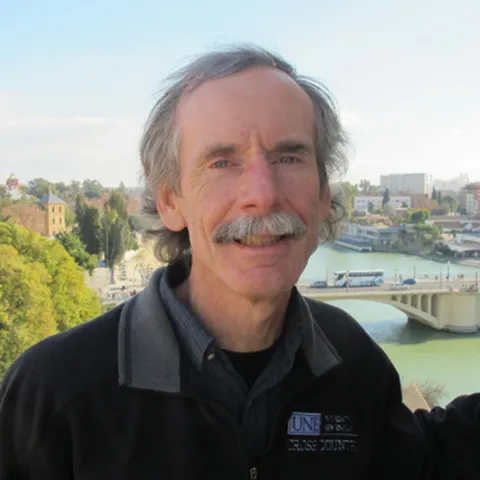
One major research area in Dr. Small’s laboratory is the investigation of how proteins belonging to the Jagged1/Notch and Fibroblast Growth Factor (FGF) families interact and regulate adipocyte differentiation in response to hormones such as insulin. Since adipose tissue development and function is also dependent on the ability of the mature fat cells to secure a vascular system that will support its metabolic requirements, the study also includes analysis of Jagged1/Notch and FGF interactions as a regulator of angiogenesis- the formation of new blood vessels from the existing vasculature.
The second research project in The Small Laboratory is a toxicology study that characterizes the effects that Polybrominated Diphenyl Ethers (PBDEs), chemicals used as flame retardants in a variety of household goods, have on mesenchymal stem cell differentiation. In particular, research is focused on analyzing the effects that these endocrine-disrupting chemicals have on mesenchymal stem cell growth dynamics and their ability to differentiate into adipocytes and osteoblasts. These studies also document the impact that early PBDE exposure has on the formation of adipose and bone. The ultimate goal of both projects is to understand the connection that these signaling mediators have on human health and disease. Both research projects use a combination of cell culture and in vivo biomedical models such as the mouse and zebrafish. Techniques include standard biochemical/molecular biology methods including quantitative RT-PCR, immunoblot, and ELISA. In addition, Dr. Small employs molecular techniques such as cloning to produce transgenic mice and zebrafish for the studies. These projects involve collaborations with scientists from UNE, Maine Medical Center Research Institute, SUNY Geneseo, University of Maine, Bates College and University of Quebec, Montreal.
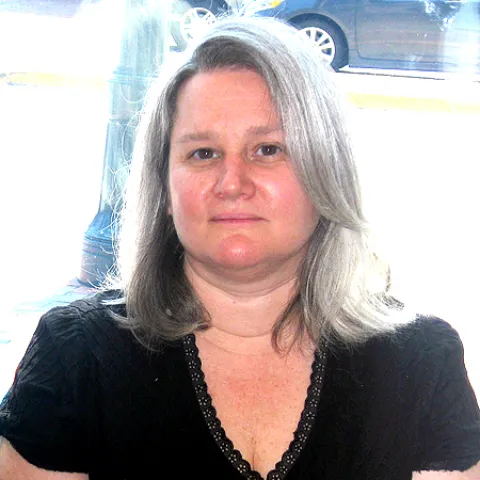
The first area is focused on DNA sensor microarray technology, which is composed of single-stranded DNA oligomers bound to a surface. The development of this technology relies on knowledge of DNA denaturation or "melting" and hybridization transitions, and their sensitivity to many variables has left several questions unanswered, such as the mechanism by which changes in physical environment between solution and bound DNA act to influence hybridization, or competitive adsorption of nearly identical sequences.
The second area attempts to improve upon separation technology using fairly innocuous materials such as supercritical carbon dioxide and polyethylene glycol to achieve what traditional processes do with more detrimental materials. Molecular simulations allow the modeling of such systems with the goal of optimizing solvation conditions and is done by carrying out calculations with varying thermodynamic (e.g. temperature and/or pressure) conditions and compositions.

"Dr. V” conducts research in the self-assembly process of four-stranded “G-wire” DNA using scanning probe microscopy (SPM). He is interested in understanding the kinetics of the self-assembly process and the interaction of the G-wire DNA with substrates and double-stranded DNA. G-wires make exciting candidates for possible nano-electronic devices, so he is interested in their electronic properties and the ability to manipulate the self-assembled structures at the microscopic level with the SPM. With the advent of fast local area networks he has safely connected the sensitive SPM to the noisy environment of the introductory physics lab using virtual network computing.
Dr. V also conducts research in the area of physics pedagogy. He is developing more effective means for teaching introductory physics through the use of multiple representation learning tools, also called “modeling,” which includes better student evaluation procedures. He has organized two workshops to train pre-service and in-service science teachers in Maine and California for the summer of 2000.
Grant support: Research Corporation, National Science Foundation, Maine Mathematics and Science Alliance.

Collaborative Projects for Biochemistry Degree Students
As a biochemistry student at UNE, you have the ability to collaborate with other students and faculty across other biological, chemical, and physical disciplines.
Learn how UNE student researchers and their faculty mentors work on an interdisciplinary research project focused on combating drug-resistant bacteria.
Experiential Learning in the Bachelor’s Degree in Biochemistry Program
Whether you’re assisting faculty members with their research, interning at a local biotech company, or designing your own experiment in the lab, hands-on learning is an integral part of your major. At UNE, you don’t just study biochemistry — you do biochemistry.
Internships for Biochemistry Majors
You may complete an internship over the summer in your hometown at sites including hospitals, private or government labs, educational institutions, or science centers. Or intern during the academic year with one of the prestigious employers with which we partner:
- IDEXX
- Lonza
- Jackson Laboratories
- Envirologix
- Katahdin Labs
For more information email the Academic and Career Advising Center at advising@une.edu.
Apply Today
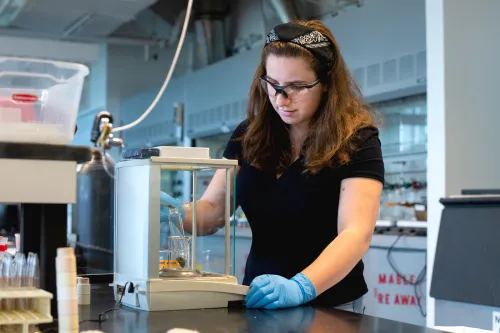
Biochemistry FAQ
What is a biochemistry major?
Biochemistry is an exciting field at the forefront of natural science, offering a perfect blend of biology and chemistry. A biochemistry major is designed to prepare students for advanced studies in various fields like biochemistry, biophysics, biotechnology, molecular biology, molecular genetics, structural biology, genetic engineering, neurobiology, and cell biology.
UNE offers a Bachelor of Science (B.S.) degree program in Biochemistry in Maine through our School of Mathematical and Physical Sciences. Our balanced curriculum assures that each student will achieve a substantial foundation in the other major chemical subdisciplines, including analytical chemistry, organic chemistry, inorganic chemistry, and physical chemistry. This major is a good choice for students who are especially interested in studying the applications of chemistry in biological systems.
Learn more about UNE’s Bachelor of Science (B.S.) degree program in Biochemistry
UNE also offers a Minor in Biochemistry that is clearly linked to career opportunities in highly skilled jobs related to science, medicine, health, and the environment, with opportunities across industry, government, and academia. It complements many existing programs at UNE, such as Medical Biology, Biological Sciences, Neuroscience, and Marine Science.
What can you do with a biochemistry degree?
Getting a bachelor's degree in biochemistry opens up many career possibilities in clinical or commercial labs, medicine, and science. It's also a good starting point for advanced medical or scientific careers.
Undergraduate biochemistry degree programs teach you the basics you need for jobs in areas like medicine, biotechnology, pharmaceuticals, food science, farming, healthcare, and forensics.
If you want to be a doctor, conduct clinical research, or become a teacher, studying biochemistry as an undergrad can prepare you for further professional or graduate programs required in your field.
UNE students who graduate with a B.S. in Biochemistry have made their marks at prestigious companies, such as Pfizer, IDEXX, and the Institute for Protein Innovation. With the knowledge, research skills, and internship experience you acquire at UNE in Maine, you can move on to have a career in many roles including biotechnology researcher, biomedical scientist, laboratory technician, research scientist, teacher, science journalist, toxicologist, forensic scientist, environmental consultant, and health care professional.
UNE students can work with our Academic and Career Advising Center to find a path that matches their passion. It doesn’t matter if you have a clear career goal or just a general interest in a field.
How much do biochemistry majors make?
As of September 2023, the average salary for biochemistry, biophysics, and molecular biology majors in the U.S. was about $52,349, as reported by Zippia. Common salary breakdowns by job according to Indeed* include:
- Research Associate: $60,227
- Analytical Chemist: $61,367
- Forensic Scientist: $62,939
- Professor: $64,284
- Microbiologist: $66,031
- Petroleum Engineer: $75,261
- Process Engineer: $87,437
- Veterinarian: $102,474
- Physician Assistant: $107,270
- Pharmacologist: $117,445
What classes do biochemistry majors take?
Biochemistry majors receive a strong educational foundation in both biology and chemistry. In addition, many biochemistry majors also complete physics and mathematics courses, including calculus. Biochemistry majors should anticipate taking lab classes where they will collaborate with partners and group members.
There are many ways UNE students can navigate our B.S. in Biochemistry. The following are just some examples of the exciting biochemistry courses that you can take:
- Advanced Biochemistry Lab
- Computational Chemistry
- Medicinal Chemistry
- Quantitative Analysis
- Advanced Lab
- Physical Chemistry
With an appropriate choice of courses, UNE students who graduate with a B.S. in Biochemistry will be prepared for entry into graduate programs in chemistry, biochemistry, medicine, dentistry, veterinary medicine, and many other fields that rely on chemistry as a fundamental science.
How long does a biochemistry degree take?
A bachelor's degree in Biochemistry is typically able to be obtained in four years. A master's degree program takes about two years to complete, while a Ph.D. program can take up to six years.
UNE’s B.S. in Biochemistry requires a minimum of 120 credit hours. This includes:
- 42-46 credits of College of Arts and Sciences (CAS) core curriculum
- 36 credits of program required courses
- 6-8 credits of program elective courses
- 34–36 open elective classes as needed to reach 120 credits
What colleges offer the best biochemistry degree program for me?
There are many factors to consider when choosing which college or university has the best biochemistry degree program for you.
Faculty
When selecting a biochemistry program, assess the faculty's qualifications and research interests. Make sure their expertise and research areas align with your passion for biochemistry and are in sync with your academic and career aspirations.
One of the standout features of UNE’s undergraduate biochemistry program is the opportunity to collaborate closely with a faculty member on an exciting research project. Below, you'll discover a few descriptions of the research projects currently conducted by our faculty members:
- Amy M. Deveau, Ph.D. - Organic and Medicinal Chemistry
- Stephen Fox, Ph.D. - Inorganic Chemistry
- Amy E. Keirstead, Ph.D. - Physical Organic Chemistry and Photochemistry
- Jerome Mullin, Ph.D. - Analytical Chemistry
- Deena J. Small, Ph.D. - Biochemistry
- John M. Stubbs, Ph.D. - Physical Chemistry
- James Vesenka, Ph.D. - Physics
Meet UNE faculty in the School of Mathematics and Physical Science
Curriculum
As a prospective college student interested in studying biochemistry, it's essential to evaluate the program's curriculum to align with your interests. Consider areas such as molecular biology, biochemical pathways, genetics, or related subjects, and investigate the availability of research opportunities and internships in the field of biochemistry.
UNE’s B.S. in biochemistry degree program in Maine is a balanced curriculum, ensuring that every student establishes a strong foundation in biochemistry and other key chemistry subfields like analytical, organic, inorganic, and physical chemistry.
Learn more about UNE’s Biochemistry curriculum
UNE biochemistry students can also take part in our GradVantage program for early admission to our medical, dental, physical therapy, and physician assistant graduate programs.
Additional graduate program pathways include a partnership with The Roux Institute at Northeastern University, another New England university based in Boston, to offer a 4+1 accelerated M.S. in Biotechnology. In this program as an undergraduate, you can take advanced courses and transfer up to 12 credits toward Northeastern's master's degree at the Roux Institute, allowing you to earn two degrees within five years. To qualify, you must be enrolled in either B.S. in Medical Biology - Medical Sciences track or the B.S. in Biochemistry program.
Career goals
Choose a biochemistry program that aligns with your career aspirations and goals. Explore the available resources to help you plan your path forward.
UNE’s biochemistry degree program in Maine offers formal and informal peer mentoring, teaching assistantships, and abundant local internship opportunities that can open the door to a number of fascinating biochemistry careers.
At UNE, hands-on learning is central to your biochemistry major. You can intern in various places, such as hospitals, labs, and educational institutions, over the summer or during the academic year. Some of our partners include IDEXX, Lonza, Jackson Laboratories, Envirologix, and Katahdin Labs.
Students wishing to enter the job market after graduation have many career options in the public and private sectors, especially in the growing biotechnology industry. UNE students can work with our Academic and Career Advising Center to find the right option. It doesn’t matter if you have a clear career goal or just a general interest in a field.
Learn more about Career Advising at UNE
Learning environment
Decide whether you want to stay within your state or explore opportunities in another state. Evaluate whether the student and faculty community aligns with your desire for inspiration and intellectual stimulation.
UNE’s Biochemistry program is situated in Morgane Hall, with additional labs in the Alfond Center for Health Sciences and the Pickus Center for Biomedical Research, all on our scenic seaside campus in Biddeford, Maine - one of three unique campuses that provide diverse learning opportunities.
Learn more about UNE’s campuses and how you can visit us
Morgane Hall contains teaching and small research labs for general chemistry, general physics, and biochemistry. Advanced chemistry labs are found on the third floor of the Alfond Center and the first floor of the Pickus Center. Pickus provides an adaptable biochemistry research space where you collaborate with faculty and have access to modern chemical and biochemical equipment in conducive facilities for learning and research.
As a biochemistry student at UNE, you can team up with fellow students and faculty from various scientific fields, such as biology, chemistry, and physics. Discover how UNE students and their mentors engage in interdisciplinary research to tackle drug-resistant bacteria.
Watch this video highlighting what collaborative research looks like at UNE
Financial aid
Does the school you are considering offer financial aid or scholarships to help you in your education?
A UNE education is very affordable. Our tuition is 16% below the average tuition for private universities in New England. All incoming full-time undergraduate students at UNE will receive Merit Scholarships in amounts from $5,000 to $22,000 per year.
Learn more about grants and scholarships available to students at UNE
UNE's Student Financial Services includes both Financial Aid and Student Accounts offices. Our program maximizes available institutional and federal funds. To discover ways to fund your education, reach out to sfs@une.edu or call (207) 602-2342 during our Monday–Friday 9 a.m.–3 p.m. office hours.

